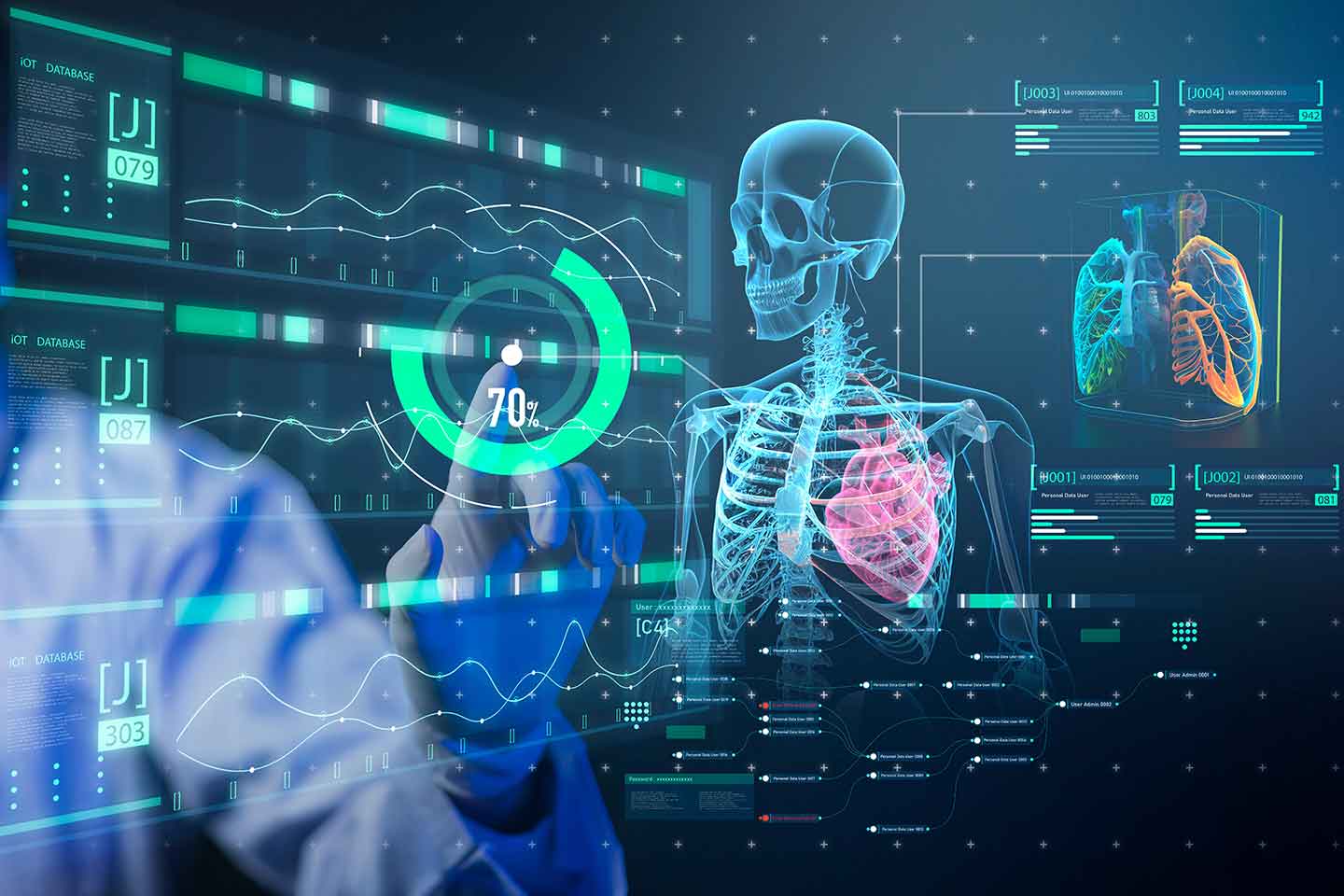From early cancer diagnosis to personalized therapies and accelerated drug development: these are just a few examples of how artificial intelligence (AI) can make medicine more powerful, efficient and safer in the future. Around the globe, researchers are working feverishly on new AI-powered software tools to optimize the entire healthcare process – from prevention to diagnosis, therapy and follow-up. In this article, we show examples outlining what AI is already accomplishing in medicine and the breakthroughs that await us.
What is artificial intelligence (AI) and what is it used for in medicine?
Artificial intelligence refers to computer algorithms that solve problems in a way that mimics human behavior. The term encompasses a number of technically diverse approaches, and the potential fields of application in medicine are correspondingly wide-ranging.
Typical examples of AI use in medicine include:
- Support in imaging diagnostics
- Development of personalized therapies
- Monitoring of chronic diseases
- Support in research and development
- Robot-assisted surgery
- Data management and administration
The purpose of AI in medicine is not to replace physicians or limit their autonomous decision-making. Rather, AI acts as an assistant or second advisor. The great strength of self-learning this groundbreaking technology lies in the fast and efficient processing and evaluation of highly complex data sets. This makes AI predestined for time, consuming, tedious and repetitive tasks which nevertheless require high precision.
7 examples of successful use of AI in medicine
But how can self-learning systems provide tangible benefits in everyday medical practice? In which areas can they relieve medical staff and improve the quality of care for patients? The following examples illustrate the opportunities opened up by the use of AI in medicine.
Example 1: Improved lung cancer, breast cancer or skin cancer diagnosis
A prime example of the successful use of self-learning AI in medicine is radiology, and in particular cancer diagnostics. Trained AI systems now detect tumors on X-ray, CT or MRI images with a precision close to that of the trained eye of radiologists.
Working on the basis of large data sets, the self-learning software is trained to distinguish between normal findings and abnormal changes. Once the learning phase is complete, the system is able to independently classify unknown images and detect conditions such as breast cancer, lung cancer or melanoma on the basis of imaging data.
When it comes to diagnosing malignant changes, this study on lung cancer, for example, has shown that human and artificial intelligence working together are more successful than either humans or machines alone.
In everyday clinical practice, the AI software often pre-classifies images and flags conspicuous findings so that medical staff can focus their attention on these cases.
Example 2: Using retinal scans to predict cardiovascular risk
Retinal scans are another interesting example of the use of AI in medicine. They are routinely used in ophthalmology practice to detect eye diseases such as diabetic retinopathy. But the retina of the eye is also a reflection of the state of the cardiovascular system as a whole, since anything that affects the cardiovascular system also leads to permanent changes in the microvessels in the eye.
Researchers at the University of Leeds recently trained an AI system using retinal scans and additional metadata to detect parallels between retinal changes and heart disease. After completing the training phase, the system was able to estimate the size and pumping efficiency of the left ventricle from retinal scans alone, as well as demographic data, to predict the risk of heart attack within the next 12 months.
In the future, AI-based retinal scans could thus be used as an efficient and cost-effective screening tool for early identification of individuals at high cardiovascular risk.
Example 3: AI-based early warning systems for epileptic seizures
Epilepsies are among the most common neurological disorders. In industrialized countries, around 0.5 to 1 percent of the population is affected. It is not always possible to control the condition completely with medication.
Due to the sudden and unexpected onset, seizures have a significant medical and psychosocial impact on patients’ lives. Early warning systems could therefore significantly improve the safety and quality of their lives.
In recent years, classical epilepsy diagnostics using EEG has been considerably improved and refined using artificial intelligence methods. This is another successful example of the use of AI in medicine. Based on subtle patterns in the EEG data, it is now possible to predict impending epileptic seizures an hour in advance – with an accuracy of 99.6%.
Future challenges will be to integrate these systems into suitable hardware and to equip patients with wearable sensors suitable for everyday use, which will provide an early warning in good time on the basis of vital data. This could help avert the impending seizure with the aid of emergency medication.
Example 4: Multi-organ monitoring systems for intensive care units
Intensive care units are another area where monitoring vital signs may literally mean the difference between life and death. Multi-organ failure is responsible for a significant number of deaths in these units. Up until now, when vital organs such as kidneys, lungs and liver are in danger of failing, each organ has been monitored separately. However, this means that organ interactions cannot always be optimally taken into account. In addition, the work of intensive care staff is considerably complicated by parallel monitoring activities.
A research group at the German Fraunhofer Institute for Cognitive Systems (IKS) is currently working on an AI-based multi-organ support system to enable integrated monitoring of the main detoxification organs – kidneys, liver and lungs – as well as blood pH in one device. Big Data pools of past patient data were used to develop the system. The self-learning software derives patterns from this and compares the current data to data from the past. On this basis, prognoses as well as suggestions for optimized treatment sequences are generated to increase patient safety and reduce the workload for intensive care staff.
Example 5: AI in medicine predicts antibiotic resistance
Antibiotic resistance is steadily increasing worldwide. Multi-resistant bacteria such as MRSA (methicillin-resistant staphylococci) pose a major threat, especially to critically ill patients in hospitals. However, to detect antibiotic resistance and find out which antibiotic may still be effective, the germs first have to be cultivated in the laboratory, wasting valuable time in the process.
Here arises another exciting example of the use of AI in medicine. A research team at ETH Zurich has now used machine learning methods to develop an AI-based system that can, in average, detect antibiotic resistance 24 hours earlier. To achieve this, the researchers linked existing mass spectrometry datasets from several laboratories and trained the AI system to identify correlations between bacterial proteins and antibiotic resistance. In a retrospective clinical case study of 63 patients, AI suggested an alternative treatment procedure in 9 cases, which would have led to an improved outcome in 8 cases.
The researchers hope that, following this example, AI-based medical prediction models could help to treat bacterial infections more effectively and thereby also reduce the use of broad-spectrum antibiotics.
Example 6: AI-based drug development
The development of new medications is time-consuming and regularly consumes large sums of research funding. The pharmaceutical industry is therefore also increasingly relying on artificial intelligence methods to simplify and accelerate the development of new drugs. Self-learning algorithms can be used profitably in almost every phase of drug development; an exemplary insight into the use of AI in this area of medicine is provided by a study from the Elsevier Public Health Emergency Collection.
If intelligent systems are trained with data on the effects and side effects of known substances, they can predict these effects for new active ingredients based on their biochemical structure. In the future, this strategy should shorten the time-consuming process of testing active substances in animal experiments and clinical trials.
Example 7: Personalized cancer therapy
Researchers have high hopes that intelligent algorithms could help in developing individually tailored treatment strategies for cancer therapy in the future. Currently, one of the major challenges in drug-based cancer treatment is the resistance of tumor cells to the active agents used. Usually, these resistances are tried to be circumvented by combination therapies. But how can the optimal combination strategy be found among the numerous possibilities?
Using Deep Learning methods, researchers have developed a model that uses known data sets on active ingredients and the properties of various cell lines to predict possible synergistic effects of different combinations of active ingredients. The use of such models could enable more effective treatment strategies in the future, thereby improving survival rates and therapeutic success.
AI in medicine: some examples of what we can expect in the future
We already see a wide range of potential uses for AI in medicine. Researchers around the world are working on promising new applications, some of which could soon make the leap from the research lab to clinical practice.
The following selected examples show which paths AI in medicine could take in the future:
- Multimodal models: the AI models in widespread use today mostly use a single data basis – such as X-ray images, EEG data or amino acid sequences. By linking heterogeneous data sources, future systems could recognize overarching patterns even more efficiently and use them to derive prognoses and treatment suggestions.
- Digital twin: One possible area of application for multimodal models is the so-called “digital twin,” i.e., a virtual image of the real person calculated by artificial intelligence. Doctors could use this representative model to test treatments and check their effects and side effects before they are used on real people.
- Integration of language models: The use of AI-based language models as chatbots has recently attracted a lot of public attention. However, using chatbots in sensitive areas such as medicine is likely to be problematic. Nevertheless, amino acid sequences can also be understood as a kind of vocabulary. In the field of biotechnology, intelligent language models are already being used to generate completely new types of proteins that do not exist in this form in nature. The method could prove particularly useful for drug development in the future.
- AI-supported robotics: Robotics and AI are a perfect team, one that has already found its way into the operating room in the form of surgical robots. Usually, these are so-called master-slave systems that are completely controlled by surgeons. As the autonomy of the systems increases, intelligent service robots could be used as nursing or assistance aids or to support physically impaired people in their independent lifestyle in the form of exoskeletons.
Using AI responsibly in medicine
As the examples presented in this article show, AI in medicine holds immense potential: it helps to optimize diagnostics and treatments, support research, and improve working conditions for medical and nursing staff. To ensure broad social acceptance, the use of AI in medicine must always take into account legal and ethical aspects such as data protection, patient safety, the right to self-determination and obligations to provide information.






